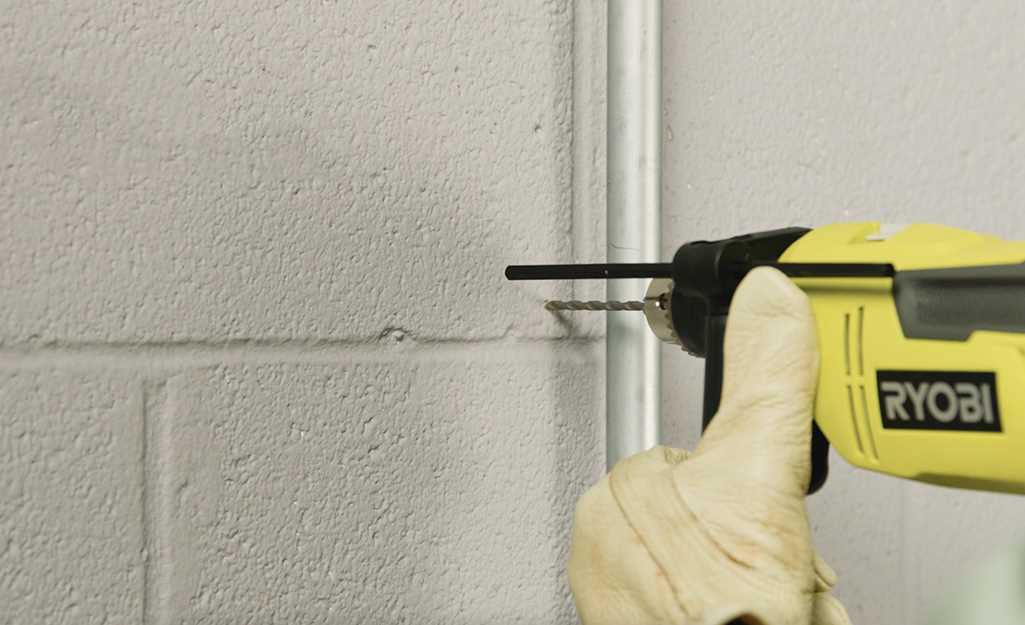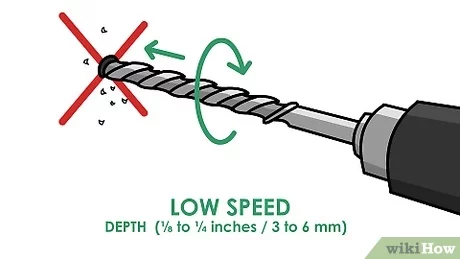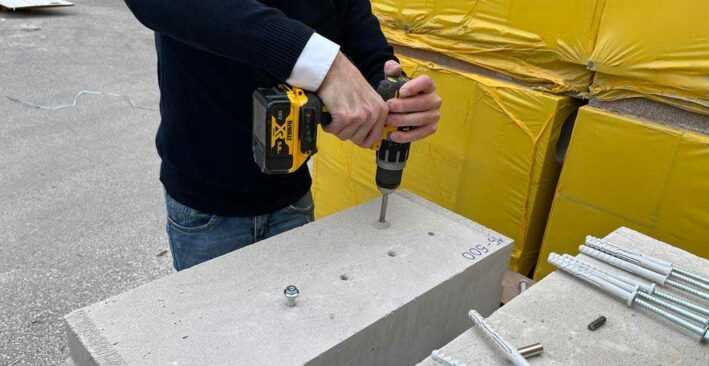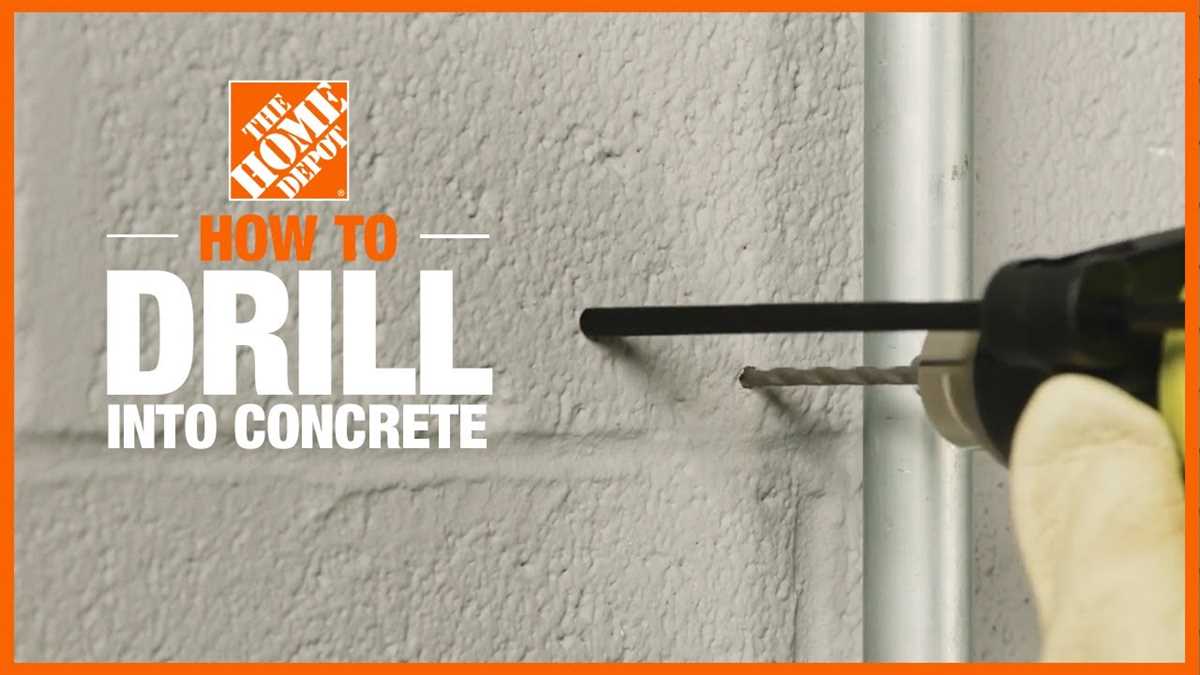Step-by-Step Guide: How to Drill into a Concrete Floor

If you are looking to install new plumbing or electrical lines, hang heavy fixtures, or perform any other task that requires drilling into a concrete floor, it is important to know the proper technique to ensure success. Drilling into concrete can be a challenging task, as it is a dense and tough material. However, with the right tools and steps, you can safely and effectively drill into a concrete floor.
Step 1: Preparation
Before you begin drilling, it is important to properly prepare the area. Start by clearing the floor and removing any objects or furniture that may obstruct your drilling path. Sweep or vacuum the area to remove any debris that may interfere with the drilling process. Next, determine the location where you will be drilling and mark it with a pencil or marker.
Step 2: Selecting the Right Drill Bit
Choosing the correct drill bit is crucial for drilling into concrete. For this task, you will need a masonry drill bit, preferably carbide-tipped, as it is specifically designed for drilling into hard materials like concrete. Make sure the drill bit is the appropriate size for the hole you need to create.
Step 3: Setting up the Drill
Attach the properly sized masonry drill bit to your drill. Set the drill to the hammer drill mode, as this will provide the necessary power and impact to penetrate the concrete. If your drill has a variable speed control, set it to a slower speed to start with, gradually increasing as needed.
Step 4: Drilling
Hold the drill perpendicular to the floor, firmly grip the handle, and apply gentle pressure as you start drilling. Begin with a slow speed to prevent the drill bit from skidding or slipping. As you progress, increase the speed and apply more pressure. Let the drill do the work and avoid forcing or leaning on it too heavily.
Step 5: Clearing the Dust
As you drill, the concrete will produce a lot of dust. To prevent the dust from accumulating and obstructing your drilling, periodically stop and clear it using a hand pump or a vacuum cleaner with a hose attachment. This will ensure that you maintain visibility and a clean drilling surface.
Step 6: Finishing the Hole
Once you have drilled deep enough, insert a piece of wire or a dowel into the hole to gauge its depth. If necessary, continue drilling until you reach the desired depth. When you are finished drilling, gently remove the drill bit from the hole and clean up any remaining debris.
By following these step-by-step instructions, you can successfully drill into a concrete floor. Remember to wear safety goggles and gloves while drilling, and take breaks as needed to avoid overheating the drill. With patience and the right tools, you can complete your drilling tasks with ease and efficiency.
Step-by-Step Guide: How to Drill into a Concrete Floor

Tools and Materials
- Power drill
- Masonry drill bit
- Hammer
- Safety glasses
- Dust mask
- Tape measure
- Pencil
- Vacuum cleaner
Step 1: Mark the drilling spot
First, determine where you need to drill the hole in the concrete floor. Use a tape measure to measure and mark the exact spot with a pencil.
Step 2: Wear safety gear

Before you start drilling, put on your safety glasses and dust mask to protect your eyes and lungs from flying debris and dust.
Step 3: Prepare the drill and drill bit
Insert the appropriate masonry drill bit into your power drill. Make sure the drill bit is securely in place.
Step 4: Start drilling
Hold the drill perpendicular to the floor and apply steady pressure. Start drilling slowly to create a pilot hole. This will help guide the drill bit and prevent it from slipping.
Step 5: Use hammer action (if necessary)

If you encounter difficulty drilling, you can switch your drill to hammer action. This will provide additional impact to break through the concrete.
Step 6: Clear dust
Periodically stop drilling to clear out the dust from the hole. Use a vacuum cleaner or a brush to remove the dust. This will ensure that the hole remains clean and the drill bit can continue to penetrate the concrete.
Step 7: Drill to the desired depth
Continue drilling until you reach the desired depth. Use caution and be patient, as drilling into concrete can take some time.
Step 8: Remove the drill bit
Once you have reached the desired depth, carefully remove the drill bit from the hole. Turn off the power drill before doing so.
Step 9: Clean up
Clean up any debris, dust, or leftover materials from the drilling process. Use a vacuum cleaner or a brush to ensure the area is clear.
Step 10: Inspect the hole
Inspect the drilled hole to ensure it is clean and meets your requirements. If necessary, use a wire brush to remove any remaining debris.
Step 11: Proceed with the intended use
With the hole drilled and cleaned, you can now proceed with the intended use, such as installing anchors, bolts, or screws into the concrete floor.
Step 12: Safety precautions
Remember to always follow safety precautions when working with power tools and concrete. Wear appropriate safety gear and take necessary measures to protect yourself and others from accidents or injuries.
Gather the necessary tools and supplies
Before you begin drilling into a concrete floor, it’s important to have all the necessary tools and supplies on hand. Here is a list of items you will need:
Tools:
- Electric drill: Make sure you have a drill with a hammer function, as this will be needed to effectively drill into the concrete.
- Masonry drill bits: These are specially designed to handle the hard surface of concrete. Make sure to have different sizes on hand to accommodate different anchor sizes.
- Safety glasses: Protect your eyes from any flying debris while drilling.
- Hammer: You may need a hammer to help anchor the drill bit into the concrete.
- Vacuum cleaner: Use a vacuum cleaner to clean up any dust or debris generated during the drilling process. This will help maintain a clean work area and prevent the dust from getting into the motor of the drill.
Supplies:
- Anchors: Depending on the project, you may need different types of anchors to secure items to the concrete floor. Common types include expansion anchors, sleeve anchors, and wedge anchors.
- Screws: Choose screws that are suitable for the anchors you are using. Make sure they are long enough to securely fasten your item to the concrete floor.
- Marking pen or pencil: Use this to mark the drilling spots on the concrete floor for precision.
- Tape measure: Measure accurately to ensure proper placement of your anchors.
Having all these tools and supplies ready before you start drilling will make the process smoother and more efficient. It’s important to use the correct tools and supplies for the job to ensure proper drilling and secure anchoring into the concrete floor.
Mark the drilling location on the concrete floor
Before you begin drilling into the concrete floor, it is crucial to mark the exact location where you want to drill. This will help ensure accuracy and prevent any mistakes that could damage the surrounding area.
Here are the steps to mark the drilling location on the concrete floor:
- Clean the area: Start by cleaning the concrete floor where you plan to drill. Remove any debris, dust, or dirt from the surface to ensure proper adhesion of the marking.
- Measure and mark: Use a tape measure to determine the exact position of the drilling location. Mark the spot with a pencil or a piece of chalk. If you are drilling multiple holes, consider using a template or a guide to maintain consistent spacing.
- Double-check the markings: Take a moment to review your markings and confirm that they are in the correct position. Use a level or a straight edge to ensure that the marks are perfectly aligned and level.
- Protect the surrounding area: To prevent any damage to the surrounding concrete floor, use masking tape or painter’s tape to create a border around the drilling location. This will provide a barrier and protect the surface from accidental scratches or chips.
By following these steps to mark the drilling location on the concrete floor, you can ensure precision and accuracy when it comes time to drill.
Prepare the drill and drill bit
Before you begin drilling into a concrete floor, it is important to make sure that you have the correct drill and drill bit for the job. Here are the steps to prepare the drill and drill bit:
- Select the right drill: Use a hammer drill or a rotary hammer drill, as these are designed specifically for drilling into concrete. A regular drill may not be powerful enough to penetrate the concrete.
- Choose the appropriate drill bit: Use a masonry drill bit made from carbide or diamond-tipped. These drill bits are specially designed to drill into concrete and can withstand the hardness of the material.
- Select the correct size drill bit: The size of the drill bit will depend on the size of the hole you want to make. Measure the diameter of the anchor or screw you plan to use and choose a drill bit slightly larger in size.
- Inspect the drill bit: Before you start drilling, check the condition of the drill bit. Look for any damage, such as chips or dullness. Replace the drill bit if it is worn out or damaged, as it may affect the drilling performance.
Once you have prepared the drill and drill bit, you are ready to move on to the next step of the drilling process.
Put on safety gear
Before drilling into a concrete floor, it is important to put on the necessary safety gear to protect yourself from any potential hazards. Follow these steps to ensure your safety:
- Safety goggles: Wear safety goggles to protect your eyes from flying debris. Concrete dust and chips can be harmful if they get into your eyes.
- Dust mask: Put on a dust mask to avoid breathing in the fine particles of concrete dust that will be created during the drilling process.
- Ear protection: Wear ear protection such as earplugs or earmuffs to prevent damage to your hearing. Drilling into concrete can be a loud and noisy process.
- Gloves: Use heavy-duty work gloves to protect your hands from sharp edges and potential injuries.
- Steel-toed boots: Wear steel-toed boots or sturdy work shoes to protect your feet from falling objects or accidental impacts.
By wearing the appropriate safety gear, you can reduce the risk of injuries and ensure a safer drilling experience.
Position the drill over the marked location
Once you have determined the correct location for drilling into your concrete floor, it’s time to position the drill in the proper spot. Follow these steps to ensure precision and safety:
- Hold the drill with both hands, gripping the handles firmly for better control.
- Align the drill bit with the marked location on the concrete floor.
- Make sure the drill is perpendicular to the floor surface for optimal drilling.
- Apply moderate pressure downward to keep the drill steady.
- Double-check the alignment before proceeding to prevent drilling mistakes.
Keep the following tips in mind when positioning the drill:
- Take your time to ensure accuracy, especially if drilling multiple holes.
- Use a level or plumb line to confirm the drill’s alignment.
- Wear safety goggles to protect your eyes from any debris that may be generated during drilling.
- Consider using a drill guide or template to guarantee consistent hole placement.
Once you are confident in the drill’s position and alignment, you are ready to start drilling into the concrete floor. Proceed cautiously and maintain a steady hand to achieve the desired results.
Start drilling slowly and steadily
When you are ready to start drilling into the concrete floor, it’s important to take your time and proceed with caution. Drilling into concrete can be a challenging task, but by following these steps, you can ensure a successful and safe drilling experience.
Step 1: Choose the right drill bit
Before you begin, make sure you have the appropriate drill bit for the job. For most concrete drilling tasks, a masonry or carbide-tipped drill bit will work best. These types of drill bits are designed to withstand the hardness of concrete and will provide optimal drilling performance.
Step 2: Mark the drilling spot
Using a pencil or marker, mark the exact spot on the concrete floor where you want to drill. This will help you stay focused and ensure that your hole is drilled in the correct location.
Step 3: Wear safety gear
Before you start drilling, it’s important to protect yourself by wearing appropriate safety gear. This should include safety glasses to protect your eyes from flying debris, as well as gloves and a dust mask to protect your hands and respiratory system from concrete dust.
Step 4: Position the drill
Hold the drill at a 90-degree angle to the concrete floor, with the drill bit directly above the marked spot. Make sure the drill is set to the appropriate speed and torque settings for concrete drilling.
Step 5: Start drilling
Slowly press the drill bit against the concrete floor and start drilling. Begin with a low speed and gradually increase the speed as you gain more control and confidence. Apply steady and even pressure, allowing the drill bit to do the work. Avoid pushing too hard or drilling too quickly, as this can cause the drill bit to overheat or break.
Step 6: Cool the drill bit
As you drill, periodically lift the drill bit out of the hole to allow it to cool down. This will help prevent overheating and prolong the life of the drill bit. You can also use a spray bottle filled with water to cool the drill bit if necessary.
Step 7: Clean the hole
Once you have drilled the desired depth, remove the drill bit from the hole and use a brush or vacuum to clean out any dust or debris. This will ensure that the hole is clean and ready for any further steps, such as inserting an anchor or screw.
By following these steps and taking your time, you can successfully drill into a concrete floor without any issues. Remember to prioritize safety and always wear the appropriate safety gear throughout the drilling process.
Monitor the drill bit and adjust speed as needed
As you begin drilling into the concrete floor, it is important to monitor the drill bit and adjust the speed as needed. Concrete can be a difficult material to drill into, and the speed at which you drill can greatly affect the outcome.
Here are some tips for monitoring the drill bit and adjusting the speed:
- Watch for signs of overheating: If the drill bit begins to smoke or emit a burning smell, it is a sign that it is overheating. To prevent damage to the bit and ensure an effective drilling process, you should stop drilling and allow the bit to cool down before continuing.
- Pay attention to drilling speed: The drilling speed will depend on the type of concrete you are drilling into. Generally, a slower speed is recommended for harder concrete, while a faster speed can be used for softer concrete. It is important to adjust the speed accordingly to avoid damaging the bit or the concrete surface.
- Apply steady and consistent pressure: Applying too much pressure can cause the drill bit to become stuck or break, while too little pressure may result in a slower drilling process. It is important to apply steady and consistent pressure to ensure a smooth and efficient drilling operation.
- Use water for cooling: To help prevent overheating of the drill bit and reduce dust, you can use water for cooling. Apply water to the drilling area periodically to keep the bit cool and lubricated.
By closely monitoring the drill bit and adjusting the speed as needed, you can ensure a safe and successful drilling process into a concrete floor.
Remove the drill and clean up the work area
Once you have finished drilling into the concrete floor, it is important to safely remove the drill and clean up the work area to ensure a safe and orderly environment. Follow these steps to complete this process:
1. Turn off the drill
Before removing the drill, make sure it is turned off to avoid any accidental injury. Switch the power button to the off position and unplug the drill from the power source.
2. Carefully remove the drill bit

Once the drill is turned off, you can carefully remove the drill bit. Hold the drill steady with one hand while using your other hand to twist the chuck counterclockwise, loosening the drill bit. Pull the drill bit out of the chuck and set it aside in a safe location, away from the work area.
3. Inspect the drill and chuck
Take a moment to inspect the drill and chuck for any damage or wear. If you notice any issues, such as a dull or damaged drill bit or a loose chuck, it may be necessary to replace these components before continuing with any further drilling projects.
4. Clean up the work area
Use a broom or vacuum cleaner to remove any concrete dust or debris from the work area. Sweeping the floor will help prevent slipping and maintain a clean environment.
5. Dispose of waste materials properly
If you have generated any waste materials during the drilling process, such as concrete dust or small concrete fragments, make sure to dispose of them properly. Check with your local waste management regulations to determine the appropriate method of disposal, as some materials may need to be taken to a specific facility for disposal.
By following these steps, you can safely remove the drill and clean up the work area after drilling into a concrete floor. This will help maintain a safe and organized environment for future projects.
FAQ:
What tools do I need to drill into a concrete floor?
To drill into a concrete floor, you will need a hammer drill, masonry drill bit, safety goggles, ear protection, a dust mask, a vacuum cleaner, and a tape measure.
Are there any safety precautions I should take when drilling into a concrete floor?
Yes, there are a few safety precautions you should take when drilling into a concrete floor. Make sure to wear safety goggles, ear protection, and a dust mask to protect yourself from debris and dust. Use the correct drill bit and drill with a hammer drill setting. Always hold the drill securely with both hands and maintain proper balance. And be mindful of any pipes or wires that may be hidden in the concrete.
How deep should I drill into a concrete floor?
The depth you should drill into a concrete floor will depend on the specific project or task you are working on. It is recommended to measure and mark the desired depth on the drill bit with tape to ensure accurate drilling. However, it is generally recommended to drill at least 1 inch deeper than the length of the anchor or screw you will be using.
What are some tips for drilling into a concrete floor?
Here are some tips for drilling into a concrete floor: 1. Start with a smaller drill bit size and gradually increase to the desired size to prevent the drill from slipping. 2. Use a vacuum cleaner or a dust extraction system to remove dust and debris while drilling. 3. Apply even pressure and let the drill do the work, without forcing it. 4. Periodically withdraw the drill to remove dust and prevent overheating. 5. Use a hammer drill with a hammer drill setting for more efficient drilling. 6. Be patient and take breaks to prevent overheating.
Video:













